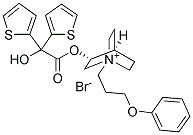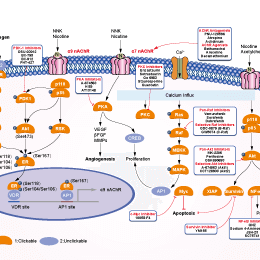
- Bioactive Compounds
- By Signaling Pathways
- PI3K/Akt/mTOR
- Epigenetics
- Methylation
- Immunology & Inflammation
- Protein Tyrosine Kinase
- Angiogenesis
- Apoptosis
- Autophagy
- ER stress & UPR
- JAK/STAT
- MAPK
- Cytoskeletal Signaling
- Cell Cycle
- TGF-beta/Smad
- DNA Damage/DNA Repair
- Compound Libraries
- Popular Compound Libraries
- Customize Library
- Clinical and FDA-approved Related
- Bioactive Compound Libraries
- Inhibitor Related
- Natural Product Related
- Metabolism Related
- Cell Death Related
- By Signaling Pathway
- By Disease
- Anti-infection and Antiviral Related
- Neuronal and Immunology Related
- Fragment and Covalent Related
- FDA-approved Drug Library
- FDA-approved & Passed Phase I Drug Library
- Preclinical/Clinical Compound Library
- Bioactive Compound Library-I
- Bioactive Compound Library-Ⅱ
- Kinase Inhibitor Library
- Express-Pick Library
- Natural Product Library
- Human Endogenous Metabolite Compound Library
- Alkaloid Compound LibraryNew
- Angiogenesis Related compound Library
- Anti-Aging Compound Library
- Anti-alzheimer Disease Compound Library
- Antibiotics compound Library
- Anti-cancer Compound Library
- Anti-cancer Compound Library-Ⅱ
- Anti-cancer Metabolism Compound Library
- Anti-Cardiovascular Disease Compound Library
- Anti-diabetic Compound Library
- Anti-infection Compound Library
- Antioxidant Compound Library
- Anti-parasitic Compound Library
- Antiviral Compound Library
- Apoptosis Compound Library
- Autophagy Compound Library
- Calcium Channel Blocker LibraryNew
- Cambridge Cancer Compound Library
- Carbohydrate Metabolism Compound LibraryNew
- Cell Cycle compound library
- CNS-Penetrant Compound Library
- Covalent Inhibitor Library
- Cytokine Inhibitor LibraryNew
- Cytoskeletal Signaling Pathway Compound Library
- DNA Damage/DNA Repair compound Library
- Drug-like Compound Library
- Endoplasmic Reticulum Stress Compound Library
- Epigenetics Compound Library
- Exosome Secretion Related Compound LibraryNew
- FDA-approved Anticancer Drug LibraryNew
- Ferroptosis Compound Library
- Flavonoid Compound Library
- Fragment Library
- Glutamine Metabolism Compound Library
- Glycolysis Compound Library
- GPCR Compound Library
- Gut Microbial Metabolite Library
- HIF-1 Signaling Pathway Compound Library
- Highly Selective Inhibitor Library
- Histone modification compound library
- HTS Library for Drug Discovery
- Human Hormone Related Compound LibraryNew
- Human Transcription Factor Compound LibraryNew
- Immunology/Inflammation Compound Library
- Inhibitor Library
- Ion Channel Ligand Library
- JAK/STAT compound library
- Lipid Metabolism Compound LibraryNew
- Macrocyclic Compound Library
- MAPK Inhibitor Library
- Medicine Food Homology Compound Library
- Metabolism Compound Library
- Methylation Compound Library
- Mouse Metabolite Compound LibraryNew
- Natural Organic Compound Library
- Neuronal Signaling Compound Library
- NF-κB Signaling Compound Library
- Nucleoside Analogue Library
- Obesity Compound Library
- Oxidative Stress Compound LibraryNew
- Plant Extract Library
- Phenotypic Screening Library
- PI3K/Akt Inhibitor Library
- Protease Inhibitor Library
- Protein-protein Interaction Inhibitor Library
- Pyroptosis Compound Library
- Small Molecule Immuno-Oncology Compound Library
- Mitochondria-Targeted Compound LibraryNew
- Stem Cell Differentiation Compound LibraryNew
- Stem Cell Signaling Compound Library
- Natural Phenol Compound LibraryNew
- Natural Terpenoid Compound LibraryNew
- TGF-beta/Smad compound library
- Traditional Chinese Medicine Library
- Tyrosine Kinase Inhibitor Library
- Ubiquitination Compound Library
-
Cherry Picking
You can personalize your library with chemicals from within Selleck's inventory. Build the right library for your research endeavors by choosing from compounds in all of our available libraries.
Please contact us at info@selleckchem.com to customize your library.
You could select:
- Antibodies
- Bioreagents
- qPCR
- 2x SYBR Green qPCR Master Mix
- 2x SYBR Green qPCR Master Mix(Low ROX)
- 2x SYBR Green qPCR Master Mix(High ROX)
- Protein Assay
- Protein A/G Magnetic Beads for IP
- Anti-Flag magnetic beads
- Anti-Flag Affinity Gel
- Anti-Myc magnetic beads
- Anti-HA magnetic beads
- Magnetic Separator
- Poly DYKDDDDK Tag Peptide lyophilized powder
- Protease Inhibitor Cocktail
- Protease Inhibitor Cocktail (EDTA-Free, 100X in DMSO)
- Phosphatase Inhibitor Cocktail (2 Tubes, 100X)
- Cell Biology
- Cell Counting Kit-8 (CCK-8)
- Animal Experiment
- Mouse Direct PCR Kit (For Genotyping)
- New Products
- Contact Us
Aclidinium Bromide
Synonyms: LAS 34273, LAS-W 330
Aclidinium Bromide (LAS 34273, LAS-W 330) inhibits human muscarinic AChR M1, M2, M3, M4 and M5 with Ki of 0.1 nM, 0.14 nM, 0.14 nM, 0.21 nM and 0.16 nM, respectively.

Aclidinium Bromide Chemical Structure
CAS No. 320345-99-1
Purity & Quality Control
Batch:
Purity:
99.56%
99.56
Aclidinium Bromide Related Products
| Related Targets | mAChR nAChR AChE | Click to Expand |
|---|---|---|
| Related Products | PNU-120596 Benzethonium Chloride Arecoline HBr Otilonium Bromide Lycorine Hyoscyamine (-)-Huperzine A (HupA) Nitenpyram Cytisine Chelidonine | Click to Expand |
| Related Compound Libraries | FDA-approved Drug Library Natural Product Library Neuronal Signaling Compound Library CNS-Penetrant Compound Library Anti-alzheimer Disease Compound Library | Click to Expand |
Signaling Pathway
Biological Activity
| Description | Aclidinium Bromide (LAS 34273, LAS-W 330) inhibits human muscarinic AChR M1, M2, M3, M4 and M5 with Ki of 0.1 nM, 0.14 nM, 0.14 nM, 0.21 nM and 0.16 nM, respectively. | ||||||||||
|---|---|---|---|---|---|---|---|---|---|---|---|
| Features | Approximately equipotent to Tiotropium, and 8-16 times more potent than Ipratropium for muscarinic receptor subtypes. | ||||||||||
| Targets |
|
| In vitro | ||||
| In vitro | [3H]Aclidinium binds to a homogeneous receptor of M2 with Kd of 0.34 nM and Bmax of 3.13 pmol/mg, and binds to M3 with Kd of 0.34 nM and Bmax of 3.13 pmol/mg. Aclidinium (< 100 nM) dose-dependently inhibits carbachol-induced contractions in isolated guinea pig trachea. Aclidinium shows an onset of action with t1/2 of 6.8 min, tmax of 35.9 min in isolated guinea pig trachea. [1] Aclidinium is hydrolysed in plasma samples from all species studied, with apparent half-lives at 37℃ of 11.7 min, 38.3 min, 1.8 min and 2.4 min in rat, guinea pig, dog and human plasma, respectively. [2] Aclidinium (0.1 μM) inhibits carbachol and TGF-β1 induced upregulation of collagen type I and α-SMA mRNA and protein expression in human bronchial fibroblasts. Aclidinium (0.1 μM) inhibits TGF-β1 induced upregulation of ChAT expression in human bronchial fibroblasts. Aclidinium (0.1 μM) inhibits carbachol- and TGF-β1-induced increases in ERK1/2 phosphorylation and RhoA-GTP formation in human bronchial fibroblasts. Aclidinium pretreatment prevents the upregulation of M1 and M3, but not M2 downregulation induced by carbachol or TGF-β1 in human lung fibroblasts. Aclidinium (0.1 μM) dose-dependently inhibits the TGF-β1 and carbachol-induced cell proliferation of human lung fibroblasts. [3] | |||
|---|---|---|---|---|
| Kinase Assay | Affinity assay | |||
| The affinity of Aclidinium for the different human muscarinic receptor subtypes at equilibrium is determined by measuring their ability to displace the binding of [3H]NMS to cell membrane preparations expressing one of the human muscarinic receptor subtypes. Protein concentrations are 8.1 μg/well, 10.0 μg/well, 4.9 μg/well, 4.5 μg/well, and 5.0 μg/well for M1, M2, M3, M4, and M5 receptor membrane preparations, respectively. The assays are conducted at [3H]NMS concentrations approximately equal to the radioligand equilibrium dissociation constant (Kd) for the different muscarinic receptors subtypes. The [3H]NMS concentration is 0.3 nM for the M1 and M4 assays and 1 nM for the M2, M3, and M5 assays. A range of antagonist concentrations (10−14 to 10−5 M) are tested in duplicate to generate competition curves. Nonspecific binding is determined in the presence of atropine (1 μM). Assay reagents are dissolved in assay binding buffer (phosphate-buffered saline with calcium and magnesium) to a total volume of 200 μL. After a 2 hours or 6 hours incubation period (M1–M4 and M5, respectively) at room temperature in 96-well microtiter plates to ensure that equilibrium is achieved for Aclidinium, 150 μL aliquots of the reaction are transferred to GF/C filter plates pretreated for 1 hour with wash buffer (50 mM Tris, 100 mM NaCl, pH 7.4) containing 0.05% polyethylenimine. Bound and free [3H]NMS are then separated by rapid vacuum filtration followed by four washes with ice-cold wash buffer. Filters are then dried for 30 min before addition of 30 μL of OptiPhase Supermix, and radioactivity is quantified using a MicroBeta Trilux microplate scintillation counter. | ||||
| Cell Research | Cell lines | Human bronchial fibroblast | ||
| Concentrations | 100 nM | |||
| Incubation Time | 48 hours | |||
| Method | Human bronchial fibroblast proliferation is measured as previously outlined by colorimetric immunoassay based on BrdU incorporation during DNA synthesis using a cell proliferation enzyme-linked immunosorbent assay BrdU kit according to the manufacturer’s protocol. Cells are seeded at a density of 3x103 cells/well on 96-well plates and incubated for 24 hours. Cells are then exposed to different experimental conditions. The 490 nm absorbance is quantified using a microplate spectrophotometer. Proliferation data refers to the absorbance values of BrdU-labeled cellular DNA content per well. Stimulation is expressed as x-fold proliferation over basal growth of the untreated control set as unity. | |||
| In Vivo | ||
| In vivo | Aclidinium shows an onset of action with IC50 (95% CI) of 140 μg/mL and tmax of 30 min in the acetylcholine-induced bronchoconstriction model in anesthetized guinea pigs. Aclidinium (500 μg/kg) induces a maximal increase in heart rate of 55% after 1 hour in conscious beagle dogs. [1] Aclidinium (1 mg/ml) produces a potent and sustained bronchoprotection (72%–88.4%) over the 120-min study period in anaesthetised guinea pigs. [2] | |
|---|---|---|
| Animal Research | Animal Models | beagle dogs |
| Dosages | 500 μg/kg | |
| Administration | Administered by using a nebulizer | |
| NCT Number | Recruitment | Conditions | Sponsor/Collaborators | Start Date | Phases |
|---|---|---|---|---|---|
| NCT03276078 | Completed | Pulmonary Disease Chronic Obstructive |
AstraZeneca |
November 23 2017 | Phase 2 |
Chemical Information & Solubility
| Molecular Weight | 564.55 | Formula | C26H30NO4S2.Br |
| CAS No. | 320345-99-1 | SDF | -- |
| Smiles | C1C[N+]2(CCC1C(C2)OC(=O)C(C3=CC=CS3)(C4=CC=CS4)O)CCCOC5=CC=CC=C5.[Br-] | ||
| Storage (From the date of receipt) | |||
|
In vitro |
DMSO : 71 mg/mL ( (125.76 mM) Moisture-absorbing DMSO reduces solubility. Please use fresh DMSO.) Water : Insoluble Ethanol : Insoluble |
Molecular Weight Calculator |
|
In vivo Add solvents to the product individually and in order. |
In vivo Formulation Calculator |
||||
Preparing Stock Solutions
Molarity Calculator
In vivo Formulation Calculator (Clear solution)
Step 1: Enter information below (Recommended: An additional animal making an allowance for loss during the experiment)
mg/kg
g
μL
Step 2: Enter the in vivo formulation (This is only the calculator, not formulation. Please contact us first if there is no in vivo formulation at the solubility Section.)
% DMSO
%
% Tween 80
% ddH2O
%DMSO
%
Calculation results:
Working concentration: mg/ml;
Method for preparing DMSO master liquid: mg drug pre-dissolved in μL DMSO ( Master liquid concentration mg/mL, Please contact us first if the concentration exceeds the DMSO solubility of the batch of drug. )
Method for preparing in vivo formulation: Take μL DMSO master liquid, next addμL PEG300, mix and clarify, next addμL Tween 80, mix and clarify, next add μL ddH2O, mix and clarify.
Method for preparing in vivo formulation: Take μL DMSO master liquid, next add μL Corn oil, mix and clarify.
Note: 1. Please make sure the liquid is clear before adding the next solvent.
2. Be sure to add the solvent(s) in order. You must ensure that the solution obtained, in the previous addition, is a clear solution before proceeding to add the next solvent. Physical methods such
as vortex, ultrasound or hot water bath can be used to aid dissolving.
Tech Support
Answers to questions you may have can be found in the inhibitor handling instructions. Topics include how to prepare stock solutions, how to store inhibitors, and issues that need special attention for cell-based assays and animal experiments.
Tel: +1-832-582-8158 Ext:3
If you have any other enquiries, please leave a message.
* Indicates a Required Field
Tags: buy Aclidinium Bromide | Aclidinium Bromide supplier | purchase Aclidinium Bromide | Aclidinium Bromide cost | Aclidinium Bromide manufacturer | order Aclidinium Bromide | Aclidinium Bromide distributor







































